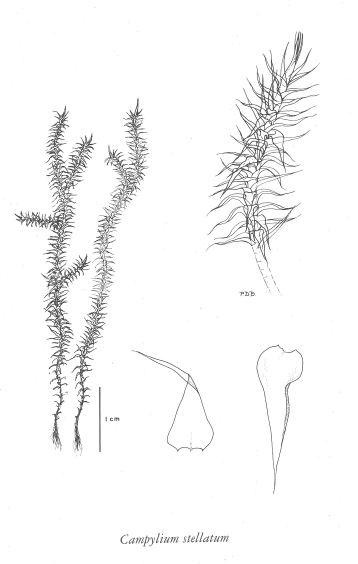Campylium stellatum var. stellatum (Hedw.) J. Lange & C. Jens
golden star-moss (star campylium moss)
Amblystegiaceae
Species Account Author: Wilf Schofield
Extracted from Some Common Mosses of BC
Introduction to the Bryophytes of BC
golden star-moss (star campylium moss)
Amblystegiaceae
Species Account Author: Wilf Schofield
Extracted from Some Common Mosses of BC
Introduction to the Bryophytes of BC
Map
Distribution of Campylium stellatum var. stellatum
Click here to view the full interactive map and legend
Species Information
Species description:
Genus name referring to curved, a possible reference to the curved sporangium; the species name describing the star-like appearance of the radiately spreading leaves of the stem and branch tips.
Reproduction:
Sporophytes infrequent; sporangia curved-subcylindric, light to dark brown; seta red to reddish-yellow, elongate; possibly propagated mainly through fragmentation of the leafy shoots.
Distinguishing characteristics:
The squarrose, narrowly triangular leaves and the relatively soft plants that grow in damp habitats usually make this plant readily recognizable .
Habit:
Forming golden green, brownish-green to dark green glossy mats of usually erect to suberect loosely interwoven shoots.
Similar Species:
Often Rhytidiadelphus squarrosus grows in the same habitat as C. stellatum; the leaves are also squarrose, but the stems are red-brown (in Campylium they are yellowish or green) and the shoots are more rigid than in Campylium. In the same habitat Dicranella palustris also has squarrose leaves but the leaves have a strong midrib and are lanceloate, the stems are never branched and the plants grow in. tight turfs on mineral soil.
Illustration

If more than one illustration is available for a species (e.g., separate illustrations were provided for two subspecies) then links to the separate images will be provided below. Note that individual subspecies or varietal illustrations are not always available.
Illustration Source: Some Common Mosses of BC
Habitat and Range
Habitat
Widespread in seepage or wet sites, especially on calcareous substrata, from sea level to subalpine elevations. In openings in subalpine forest it frequents springs while at lower elevations it is frequent on cliffs near waterfalls. Range
World DistributionWidely distributed in the Northern Hemisphere, especially at arctic and boreal latitudes and in mountains, southward to mountains of Africa. In North America extending southward in mountains to Georgia in the east and to California in the west; also in Mexico and Guatemala.
Status Information
| Scientific Name | Origin Status | Provincial Status | BC List (Red Blue List) | COSEWIC |
|---|---|---|---|---|
| Campylium stellatum | S5 (2011) | Yellow | Not Listed | |
| Campylium stellatum var. protensum | Native | S3S4 | Yellow | Not Listed |
| Campylium stellatum var. stellatum | Native | S5 | Yellow | Not Listed |
BC Ministry of Environment: BC Species and Ecosystems Explorer.
Synonyms
Synonyms and Alternate Names:
Amblystegium stellatum (Hedw.) Lindb.